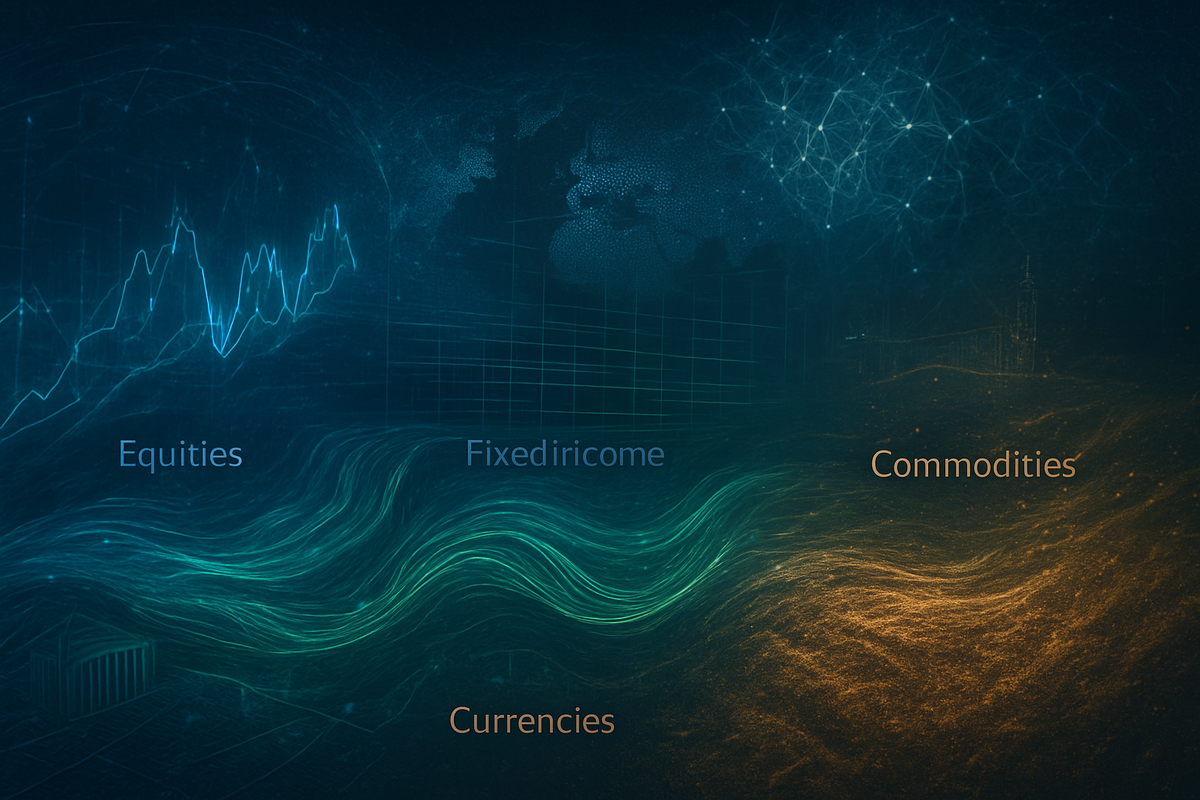
As of November 17, 2025, the financial world is witnessing a profound transformation in how market trends are identified and analyzed, particularly within the volatile realm of commodities. The increasing accessibility and sophisticated application of "cross-asset signals" are at the heart of this evolution. These signals, derived from the interconnected movements and relationships between various financial asset classes—such as equities, fixed income, currencies, and commodities—offer a holistic lens through which to interpret global market behavior. By understanding these interdependencies, traders and investors can gain a more comprehensive and accurate interpretation of overall market dynamics, moving beyond the limitations of single-asset analysis.
The immediate implication of this trend is a significant enhancement in decision-making capabilities and portfolio performance. What was once the exclusive domain of institutional traders and hedge funds is now becoming democratized, with modern analytics platforms actively making these powerful insights available to a wider range of market participants. This shift promises optimized portfolio performance, better anticipation of market reversals, and the ability to make real-time adjustments, ultimately leading to more resilient investment outcomes in an increasingly complex and interconnected global economy.
The Genesis and Evolution of Intermarket Intelligence
Cross-asset signals are generated through a sophisticated interplay of diverse data sources, methodologies, and advanced analytical techniques. At their core, they analyze price movements, momentum, and macroeconomic indicators across various markets. For instance, "cross-asset time series momentum" strategies identify that past bond market returns can positively predict future equity market returns, and vice versa, while economic factors like GDP growth, inflation data, and central bank policies (e.g., interest rate adjustments) profoundly shape these correlations. The options market also provides valuable data, with options traders' activities often signaling underlying trends in equity prices due to their higher conviction.
The journey of cross-asset signal utilization spans decades, with significant acceleration in recent years. The theoretical foundations were laid in the 1980s and 1990s, with early multi-asset class pricing toolkits emerging from companies like Numerix in 1996. The 2000s saw the rise of time series momentum, notably with the foundational paper "Time Series Momentum" by Tobias Moskowitz, Yao Hua Ooi, and Lasse Pedersen in 2012. By the mid-2010s, formal documentation of "cross-asset time series momentum" emerged, demonstrating the predictive power of one asset class's returns for another. The 2020s have been marked by a surge in advanced analytics and accessibility, driven by Artificial Intelligence (AI) and Machine Learning (ML). As of November 2025, AI and ML algorithms are revolutionizing cross-asset correlation analysis, processing vast datasets to detect complex, non-linear relationships and predict shifts in real-time, often with high predictive accuracy. Platforms like Investor10 are actively democratizing access to these strategies for individual traders, reflecting a significant shift in market accessibility.
Key players and stakeholders in this evolving landscape include financial institutions such as hedge funds and asset managers like Lombard Odier Investment Managers (LOIM) and AllianceBernstein (AB), who actively develop and implement multi-asset strategies. Technology and analytics providers are central, with Numerix being a leader in cross-asset analytics and software, and firms like ExtractAlpha and Macrosynergy offering specialized trading signals. Data providers like Bloomberg and FactSet Research Systems Inc. (FDS) supply the essential raw market and economic data. Academic researchers have also played a crucial role in validating these phenomena.
The industry's reaction to the increasing accessibility and sophistication of cross-asset signals has been overwhelmingly positive. There's a clear shift from siloed to integrated analysis, with a strong recognition of enhanced performance and a broad embrace of technology and AI. The democratization of these tools is also enabling broader adoption. However, initial reactions also highlight the continued importance of domain expertise, as well as the need to monitor correlation instability, especially during periods of market stress. The phenomenon of "slow-moving capital" across asset classes, driven by organizational and funding frictions, is seen as a persistent inefficiency that cross-asset signals aim to exploit.
Winners and Losers in the New Analytical Paradigm
The increasing accessibility and utilization of cross-asset signals, particularly those powered by AI and ML, are creating a clear dichotomy in the public markets as of November 2025. Companies that proactively embrace and effectively leverage these sophisticated analytical tools are poised for significant competitive advantages, while those that lag in adoption risk substantial disadvantages.
Public Companies Poised to Win:
- Financial Technology (FinTech) and Data Analytics Providers: Firms like LSEG (London Stock Exchange Group, LSEG.L), through platforms such as LSEG Workspace and StarMine, are at the forefront, offering comprehensive cross-asset data, analytics, and AI solutions. Their strategic partnership with Microsoft Corporation (MSFT) for AI-ready data infrastructure further solidifies their position. Similarly, Virtu Financial Inc. (VIRT), a prominent financial services firm, leverages cutting-edge technology for execution services, data, and analytics across global and multi-asset classes. Specialized AI commodity forecasting platforms (e.g., ChAI, Vesper) are also emerging as key players. These companies will see increased subscription revenues, an expanded client base, and opportunities to develop higher-value products, solidifying their market leadership through superior algorithms and extensive datasets.
- Large Commodity Trading Firms (with substantial technology investments): Publicly traded energy giants with robust trading arms, such as BP plc (BP) and Shell plc (SHEL), or specialized trading houses like Glencore plc (GLEN), stand to benefit immensely. Their business models will shift towards data-driven, algorithmic trading and comprehensive risk management, enabling them to identify and exploit arbitrage opportunities and optimize global supply chains more effectively. This will lead to increased trading profits, reduced losses from adverse price movements, and a stronger competitive edge against less technologically advanced rivals.
- Companies with Significant Commodity Input Costs (proactive adopters of advanced analytics): Industries heavily reliant on raw materials, such as agricultural processors like Archer-Daniels-Midland Company (ADM) and Bunge Global SA (BG), airlines like Delta Air Lines, Inc. (DAL) and Southwest Airlines Co. (LUV), and large manufacturing firms like Dow Inc. (DOW) and LyondellBasell Industries N.V. (LYB), can gain a significant advantage. By implementing proactive procurement strategies and robust hedging programs based on cross-asset insights, they can achieve substantial cost savings, more stable profit margins, and increased resilience against market shocks, outperforming slower-to-adapt competitors.
Public Companies Poised to Lose:
- Commodity Trading Firms (lagging in technology adoption): Smaller, regional trading desks or boutique firms that lack the capital, infrastructure, or expertise to invest in sophisticated data science and AI will struggle. Their continued reliance on traditional, slower analysis will mean missing emerging trends and optimal hedging windows, leading to reduced trading profits and increased exposure to adverse price movements. They will progressively lose market share and find it harder to attract top talent.
- **Traditional Manufacturing and Consumer Goods Companies (slow to adopt predictive analytics):Firms that primarily offer raw, una-analyzed data feeds or basic analytical tools without integrating sophisticated cross-asset capabilities or AI-powered insights will see their offerings become less appealing. They risk losing key clients to more comprehensive platforms, leading to declining revenues and a shrinking market presence as they are perceived as outdated and less effective compared to next-generation FinTech companies and established players like LSEG or Bloomberg.
A Broader Canvas: Significance and Ripple Effects
The increasing accessibility and utilization of cross-asset signals mark a pivotal moment in financial market intelligence, extending far beyond immediate trading profits. This shift fits squarely within broader industry trends, particularly the relentless march of quantitative finance and the transformative power of AI in trading. Quants are continually refining systematic cross-asset strategies to build robustness, while AI-powered algorithms are enabling optimized trade execution, pattern identification, and dynamic strategy adjustments in real-time. In commodity trading, AI is deployed to forecast supply and demand, detect unusual market events, and optimize complex logistical assets, acting as a "financial detective" connecting dots across diverse markets.
The ripple effects on competitors and partners are substantial. Competition in commodity markets is intensifying, with digitally advanced participants disrupting existing market structures. The democratization of advanced trading capabilities is leveling the playing field, allowing smaller firms and individual traders to access sophisticated analysis previously limited to institutions. For partners, particularly banks involved in commodity trade finance, the emergence of digital alternatives (e.g., stablecoins for trade finance) could reduce demand for conventional lending, pressuring them to innovate or form partnerships with blockchain companies.
Regulatory and policy implications are also evolving. There's an increasing regulatory divergence across jurisdictions, particularly between the US and EU, regarding digital assets and AI. The EU's AI Act, the world's first comprehensive AI regulation, will likely have global implications. Regulators are grappling with "innovation exemptions" for DeFi and digital asset products, balancing fostering innovation with concerns about creating an uneven playing field. The push towards 24/7 markets also challenges existing regulatory frameworks. Investors are increasingly integrating "policy foresight" into their decisions, recognizing that regulatory volatility impacts deal velocity.
Historically, this evolution mirrors past transformative shifts. The transition from open outcry to electronic trading platforms dramatically increased efficiency and broadened market participation, much like how cross-asset analysis is democratizing sophisticated strategies today. The development of futures contracts in the 18th-19th centuries revolutionized risk management for commodities; similarly, AI-driven cross-asset analysis provides a new layer of sophistication. Throughout history, technological advancements have consistently led to more efficient markets and altered price discovery mechanisms, a trend that the current wave of AI and advanced analytics is continuing to drive.
The Horizon: Navigating What Comes Next
As of November 2025, the future of cross-asset signals in commodity markets promises both unprecedented opportunities and persistent challenges. In the short term (next 1-2 years), we can expect wider accessibility of AI tools, higher-frequency macroeconomic signals generating daily or weekly trading insights, and commodities increasingly serving as leading indicators for equities. Precious metals are anticipated to solidify their position as core assets, influenced by evolving monetary policies and national debt concerns, though short-term volatility is expected to persist.
In the long term (3-5+ years), AI and machine learning will become indispensable core competencies for generating analytical insights and maintaining competitiveness. Cross-asset trading will see significant improvements in market microstructure analysis, sophisticated risk management, and seamless integration of diverse alternative data sources. Commodity trading firms will need to diversify their value sources and explore new business models, particularly tapping into emerging commodities driven by the global energy transition, with significant dislocations anticipated in natural gas markets later in the decade.
Strategic pivots and adaptations are crucial. Traders must adopt adaptive strategies, continuously adjusting to real-time macroeconomic indicators and geopolitical events, as correlations are not static. Robust trading infrastructure, comprehensive data management (including "data refineries" to unify disparate datasets), and a strong emphasis on human-machine collaboration will be essential. Firms must foster a cultural readiness for AI/ML projects and align leadership, legal, and compliance with their data strategies.
Market opportunities include enhanced returns from capitalizing on diverse market dynamics and exploiting arbitrage opportunities, early trend identification, and value arbitrage given the historically cheap valuations of commodities relative to equities. The energy transition will unlock new commodity markets (e.g., battery energy storage systems). Challenges, however, remain significant: the dynamic nature of correlations, complex liquidity management across diverse asset classes, the impact of "black swan" events, ensuring high data quality, and navigating economic headwinds like higher interest rates impacting new commodity projects.
Potential scenarios range from an accelerated democratization and sophistication, leading to more informed and data-driven markets, to enhanced predictive power and risk management resulting in more robust portfolios. We could see dynamic regime-based trading, where firms swiftly adapt to new market conditions, and a reshaping of commodity markets with increased institutional and retail flows into real assets. However, persistent challenges amidst advancement, where "black swan" events and rapidly shifting correlations occasionally break even advanced models, underscore the continued necessity of human expertise alongside AI.
The Unfolding Narrative: A Market Reshaped
The integration of cross-asset signals into commodity market analysis is fundamentally reshaping how investors understand and interact with global markets. It is no longer merely an advanced technique but a foundational element for robust decision-making in an era defined by interconnectedness and rapid change.
Key Takeaways from this transformation include:
- Interconnectedness as a Core Principle: Commodity prices are now understood through a holistic lens, where macroeconomic shifts, financial market trends, and geopolitical dynamics are inseparable drivers.
- AI and Data as the New Frontier: The power of AI and machine learning to process vast, disparate datasets and uncover complex, non-linear relationships is revolutionizing predictive analysis and risk management.
- Democratization of Sophistication: What was once exclusive to institutional players is now becoming accessible to a broader market, leveling the playing field and fostering greater market efficiency.
- Commodities as a Macro Barometer: Commodities serve as a vital "truth test" for macroeconomic trends, offering tangible insights into real-world supply and demand that often precede broader financial market shifts.
Assessing the Market Moving Forward: Commodity markets are poised for continued dynamism, with cross-asset signals becoming even more critical for navigating volatility. The energy transition will introduce new interdependencies, requiring sophisticated models to understand evolving correlations between traditional and emerging commodities. Persistent volatility, driven by geopolitical instability and climate events, will necessitate dynamic hedging and continuous portfolio rebalancing.
Final Thoughts on Significance and Lasting Impact: The lasting impact of cross-asset analysis will be a paradigm shift towards more integrated and adaptive investment strategies. Its significance lies in providing a more comprehensive, nuanced understanding of market dynamics, allowing investors to better anticipate reversals, optimize diversification, and improve risk management. This approach will lead to more resilient investment outcomes, particularly in periods of heightened macro uncertainty.
What Investors Should Watch For in Coming Months: Investors must remain vigilant and monitor several key cross-asset signals:
- Monetary Policy and Real Yields: Central bank actions, especially from the Federal Reserve, regarding interest rates and quantitative measures will profoundly influence currency strength and, consequently, dollar-denominated commodity prices.
- Geopolitical Developments: Ongoing tensions in commodity-producing regions can trigger supply chain disruptions and price spikes; their spillover effects across markets are crucial to watch.
- Global Economic Growth Indicators: Leading indicators like GDP growth, industrial production data, and manufacturing PMIs will signal demand trends for cyclical commodities.
- Currency Movements: The strength or weakness of the US dollar will continue to be a primary cross-asset signal for all dollar-denominated commodities.
- Supply-Demand Fundamentals and Energy Transition: While cross-asset signals provide context, commodity-specific fundamentals (production, inventories, weather) remain vital, as does the pace of energy transition infrastructure development.
- Cross-Asset Correlation Shifts: Closely observe changes in correlations between different asset classes. A decreasing correlation between equities and commodities, for example, could highlight commodities' renewed attractiveness as a portfolio diversifier.
By actively integrating these cross-asset signals into their analytical frameworks, investors can gain a distinct edge in navigating the complex and ever-evolving commodity markets of late 2025 and beyond.
This content is intended for informational purposes only and is not financial advice







